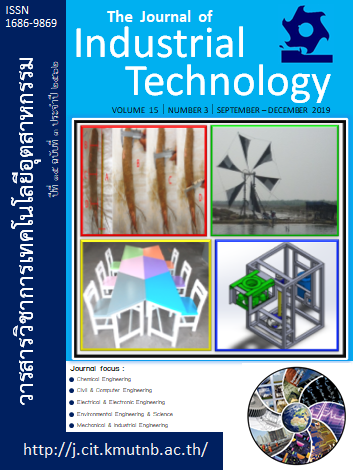(การออกแบบและพัฒนาผลิตภัณฑ์ชุดโต๊ะ-เก้าอี้เรียนระดับอนุบาลจากไม้ยางพาราโดยใช้เทคนิคการกระจายหน้าที่เชิงคุณภาพ)
คำสำคัญ:
การกระจายหน้าที่เชิงคุณภาพ, เฟอร์นิเจอร์ในชั้นเรียน, นักเรียนอนุบาล, ไม้ยางพาราบทคัดย่อ
งานวิจัยนี้เป็นการประยุกต์ใช้เทคนิคการกระจายหน้าที่เชิงคุณภาพ (Quality Function Deployment; QFD) เพื่อการออกแบบและพัฒนาผลิตภัณฑ์เฟอร์นิเจอร์ในชั้นเรียนระดับอนุบาลจากไม้ยางพารา โดยมีวัตถุประสงค์เพื่อออกแบบเฟอร์นิเจอร์ในชั้นเรียนระดับอนุบาลให้ตอบสนองต่อกลุ่มผู้ใช้งาน ทั้งรูปร่างและลักษณะการใช้งานที่ตรงต่อความต้องการ โดยเริ่มต้นดำเนินงานวิจัยนี้ด้วยการศึกษาข้อมูลการเรียนการสอนในห้องเรียนของนักเรียนอนุบาลเพื่อเป็นข้อมูลในการกำหนดกลุ่มตัวอย่างในการดำเนินงานวิจัย จากนั้นศึกษาเสียงความต้องการของผู้ใช้ และออกแบบแบบสอบถามเพื่อหาคะแนนความสำคัญในแต่ละความต้องการของผู้ใช้ นำข้อมูลความต้องการของผู้ใช้และคะแนนความสำคัญมาวิเคราะห์ด้วยเทคนิค QFD แยกออกเป็น 2 เมทริกซ์ คือ เมทริกซ์การวางแผนผลิตภัณฑ์โดยทำการแปลงความต้องการของผู้ใช้ไปเป็นความต้องการทางเทคนิค และเมทริกซ์การออกแบบชิ้นส่วนโดยทำการแปลงความต้องการทางเทคนิคไปเป็นข้อกำหนดคุณลักษณะของชิ้นส่วน และนำผลที่ได้ไปออกแบบทั้งทางด้านขนาด รูปแบบ รูปทรง สีสัน และขึ้นรูปผลิตภัณฑ์ ผลลัพธ์จากการดำเนินงานวิจัยแสดงให้เห็นการประยุกต์ใช้เทคนิค QFD ในการกำหนดคุณลักษณะของชิ้นส่วนซึ่งสามารถนำไปออกแบบเฟอร์นิเจอร์ในชั้นเรียนให้มีรูปร่างและการใช้งานที่ตรงกับความต้องการของผู้ใช้งาน โดยพบว่า ผลิตภัณฑ์ใหม่มีค่าความพึงพอใจเพิ่มขึ้นมากกว่าผลิตภัณฑ์เดิมในทุกคุณลักษณะ ซึ่งมีค่าเฉลี่ยความพึงพอใจโดยรวมของผลิตภัณฑ์รูปแบบใหม่เท่ากับ 4.373 คะแนน ในขณะที่ค่าเฉลี่ยความพึงพอใจโดยรวมของผลิตภัณฑ์รูปแบบเก่ามีค่าเท่ากับ 3.437 คะแนน ซึ่งเพิ่มขึ้นจากเดิม 22.23 เปอร์เซ็นต์
เอกสารอ้างอิง
[1] K. Intaranont, “Ergonomics”, Chulalongkorn University Press, Bangkok, 2005. (in Thai)
[2] K. Sengna, “Study and Development of the Learning Art Table and Chair Set”, Master Thesis, Faculty of Industrial Education and Technology, King Mongkut’s Institute of Technology Ladkrabang, Thailand, 2007. (in Thai)
[3] S. A. Oyewole, J. M. Haight and A. Freivalds, “The Ergonomic Design of Classroom Furniture/Computer Work Station for First Graders in the Elementary School”, International Journal of Industrial Ergonomics, 40 (4), 2010, pp.437-447.
[4] S. Milanese and K. Grimmer, “School Furniture and the User Population: An Anthropometric Perspective, Ergonomics, 47 (4), 2004, pp.416-426.
[5] I. N. Ismail, K. Ab. Halim, K. S. M. Sahari, A. Anuar, M. F. A. Jalal, F. Syaifoelida, and M. R. Eqwan, “Design and Development of Platform Deployment Arm (PDA) For Boiler Header Inspection at Thermal Power Plant by Using the House of Quality (HOQ) Approach”, Procedia Computer Science, 105, 2017, pp.296-303.
[6] Sh. S. Patil, C. Gopinath and S. Suresha, “Design and Development of an Automated Pottery Wheel for MSME”, MSRUAS-SAS Tech Journal, 15(1), 2016, pp.21-24.
[7] R. Sinthavalai and S. Ruengrong, “An Application of House of Quality (HOQ) for Designing Rice Product as a Souvenir”, Naresuan University Journal: Science and Technology, 26(3), 2018, pp.36-51. (in Thai)
[8] A. Pinta, “The Improvement of Product by Using Quality Function Deployment (QFD) Technique: A Case Study of an Educational Wood Toy Factory”, The Journal of King Mongkut's University of Technology North Bangkok, 13(4), 2003, pp.36-42. (in Thai)
[9] G.B. Crawford, “The Geometric Mean Procedure for Estimating the Scale of a Judgment Matrix”, Mathematical Modeling, 9(3), 1987, pp. 327-334.
[10] A. Kengpol, “Concurrent Engineering”. Publishing Center of King Mongkut Institute of Technology North Bangkok, Bangkok, 2004.
[11] R. Sinthavalai, P. Boonchu and S. Polmai, “An Application of House of Quality (HOQ) in Improving a Package of Medical Equipment”, The Journal of KMUTNB, 26 (3), 2016, pp.437-450. (in Thai)
[12] M. E. González , G. Quesada and A. T. Bahill, “Improving Product Design Using Quality Function Deployment: The School Furniture Case in Developing Countries”, Quality Engineering, 16 (1), 2003, pp.45-56
[13] A. Chumphoo and A. Kengpol, “The Improvement of Product by Using Quality Function Deployment (QFQ) Technique: A Case Study of an Educational Wood Toy Factory”, The Journal of KMUTNB, 13 (4), 2003, pp.36-42. (in Thai)
[14] N. Meemongkol, P. Junsong and W. Santiamorntut, “Application of Quality Function Deployment Technique for Searching of Device Characteristic and Design of Health Care Monitoring Device”, KKU Res. J, 17 (4), 2012, pp.515-527. (in Thai)
[15] C. Homkhiew, T. Ratanawilai and K. Pochana, “Application of a Quality Function Deployment Technique to Design and Develop Furniture Products”, Songklanakarin J. Sci. Technol, 34 (6), 2012, pp.663-668.
[16] Ch. Sritong and O. Sritong, Product Development Using Quality Function Deployment (QFD) in Furniture Industry: A Case Study of Office Chair Design, Valaya Alongkorn Review (Humanities and Social Science), 6 (2), 2016, pp.111-124. (in Thai)
[17] Th. Pirom, S. Rawangwong, J. Chattong and W. Boonchouytan, “The Ergonomic Design of Classroom Furniture/Art Desk-Sets for Kindergarten School”, The 4th National Conference of Industrial Operations Development, Bangkok, 2013, pp.240-246. (in Thai)


